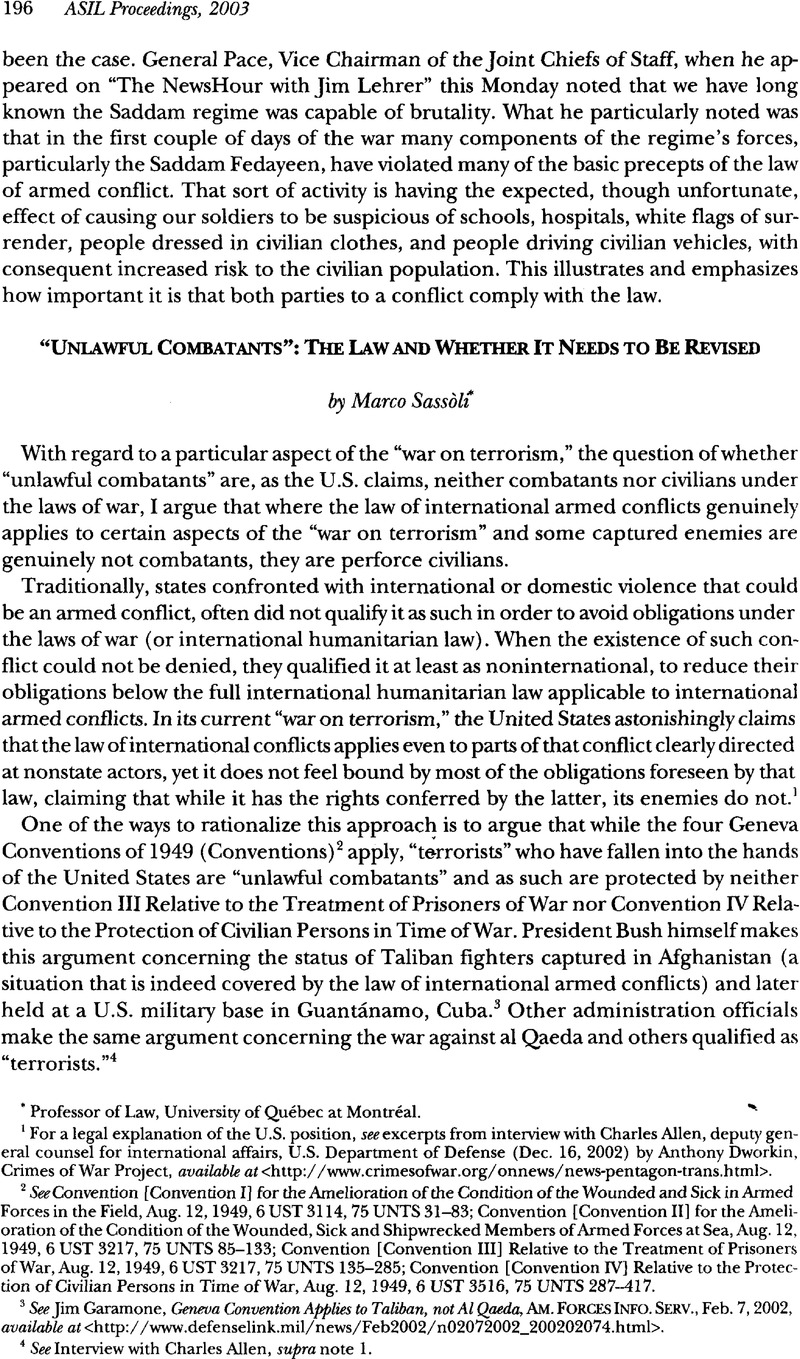Article contents
“Unlawful Combatants”: The Law and Whether It Needs to Be Revised
Published online by Cambridge University Press: 28 February 2017
Abstract

- Type
- WarJus to War: Jus
- Information
- Copyright
- Copyright © American Society of International Law 2003
References
1 For a legal explanation of the U.S. position, see excerpts from interview with Charles Allen, deputy general counsel for international affairs, U.S. Department of Defense (Dec. 16, 2002) by Anthony Dworkin, Crimes of War Project, available at <http://www.crimesofwar.org/onnews/news-pentagon-trans.html>.
2 See Convention [Convention I] for the Amelioration of the Condition of the Wounded and Sick in Armed Forces in the Field, Aug. 12, 1949, 6 UST 3114, 75 UNTS 31-83; Convention [Convention Ii] for the Amelioration of the Condition of the Wounded, Sick and Shipwrecked Members of Armed Forces at Sea, Aug. 12, 1949, 6 UST 3217, 75 UNTS 85-133; Convention [Convention Iii] Relative to the Treatment of Prisoners of War, Aug. 12, 1949, 6 UST 3217, 75 UNTS 135-285; Convention [Convention IV] Relative to the Protection of Civilian Persons in Time of War, Aug. 12, 1949, 6 UST 3516, 75 UNTS 287-417.
3 See Jim Garamone, Geneva Convention Applies to Taliban, not Ai Qaeda, Am. Forces Info. Serv., Feb. 7, 2002, available at <http://www.defenselink.mil/news/Feb2002/n02072002_200202074.html>.
4 See Interview with Charles Allen, supra note 1.
5 See Geneva Conventions, supra note 2, [common] art. 3.
6 That “unlawful combatants” are protected by Convention Iv is also recognized by Baxter, Richard R., So-Called “Unprivileged Belligerency: “Spies, Guerillas and Saboteurs, 28 Brit. Y.B. Int’l L. 323, 328, 344 (1951)Google Scholar. When the concept of “unlawful combatants” was used by the U.S. Supreme Court in Ex Parte Quirin, 317 U.S. 1 (1942), Convention Iv did not yet exist.
7 See Prosecutor v. Tadicjudgment, No. It-94-1-A, paras. 163-69 (July 15, 1999), 38 ILM 1518, 1549-51 (1999).
8 ICRC, Commentary, Iv, Geneva Convention Relative to the Protection of Civilian Persons in Time of War 51 (J.S. Pictet ed., 1958).
9 Revised and New Draft Conventions for the Protection of War Victims, Remarks and Proposals Submitted by the ICRC 68 (1949).
10 Convention III, supra note 2, art. 5(2).
11 See Aldrich, George H., The Taliban, Al Qaeda and the Determination of Illegal Combatants, 96 AJIL. 891 (2002)CrossRefGoogle Scholar; Sassòli, Marco, La “guerre contre le terrorisme,” le droit international humanitaire et le statut de prisonnier de guerre, 39 Can. Y.B. Int’l L. 211 (2001)Google Scholar
12 According to the letter of Article 4, those conditions pertaining to the presence of a responsible commander, the wearing of a fixed distinctive sign, the carrying of arms openly, and respect for the laws of war concern only militias and resistance movements, but some consider them to also apply to members of regular armed forces. Contra Aldrich, supra note 11, at 894.
13 Confirmed in Article 51 (3) of Protocol Additional to the Geneva Conventions of 12 August 1949, and relating to the Protection of Victims of International Armed Conflicts, of June 8, 1977, 1125 UNTS 3-434.
14 See Convention IV, supra note 2, arts. 42, 78.
15 See id., art. 5(1), (2), respectively.
16 The United States does not claim that such people may be tortured or be treated inhumanely.
17 See Convention Iv, supra note 2, arts. 49, 76.
18 See, e.g., Detainee Attempts Suicide, N.Y. Times, Apr. 2, 2003, at B15, available at available at <http://www.nytimes.com/aponline/international/AP-Guantanamo-Suicide-Attempt.html>.
19 See Meron, Theodor, The Humanization of Humanitarian Law, 94 AJIL 239 (2000)CrossRefGoogle Scholar.
20 For a postmodern process aiming not at new treaty rules but at action-oriented research, informal discussions with governments, and possibly “new interpretations,” see Informal High-Level Expert Meeting on the Reaffirmation and Development of International Humanitarian Law (IHL) and its follow-up, Harvard Program on Humanitarian Policy and Conflict Research, available at <http://www.hsph.harvard.edu/hpcr/ihl_research_meeting.htm>.
- 2
- Cited by


